On the smuggler’s trail to the source of the strong, illegal rum that remains an essential part of Malagasy rituals and daily drinking.
I’ve been drunk for days, relentlessly rinsing my brain in bootleg rum. I try to ponder what this quest in moonshine country is doing to my mental capacities. But the thought drains from my mind and I return to admiring my attractive surroundings.
We are on a morning commute with Madagascar’s bootleggers. Ahead and behind me, hundreds of smugglers jog in single file. Under my feet, the well-worn rock of an ancient trail winds between ridges. All around us, primary forest gleams in last night’s heavy dew. Our destination is a valley at the edge of the mountains, the source of the region’s toaka gasy.
In Madagascar, toaka gasy describes any rum produced without an official licence and literally translates as “Malagasy alcohol.” Determining its origins are difficult, but its history is lengthy enough for the liquid to have seeped into the fabric of the island. And despite the prominence of Madagascar’s legal rum brands, toaka gasy remains an essential part of rituals, important events, and daily drinking from Diego Suarez in the north to Fort Dauphin in the south.
I’ve been on the receiving end of toaka gasy a number of times. My impression has always been that the distiller was aiming at the best possible price to proof ratio with little regard for subtleties like taste. But millions of Malagasies, as the people of Madagascar are known, do not share my quibbles and the market for affordable, super-strength alcohol is vast. The distillers responsible for satisfying this thirst are often local sugarcane farmers, who turn a small profit by putting some of their sugarcane harvest toward the inebriation of their community.
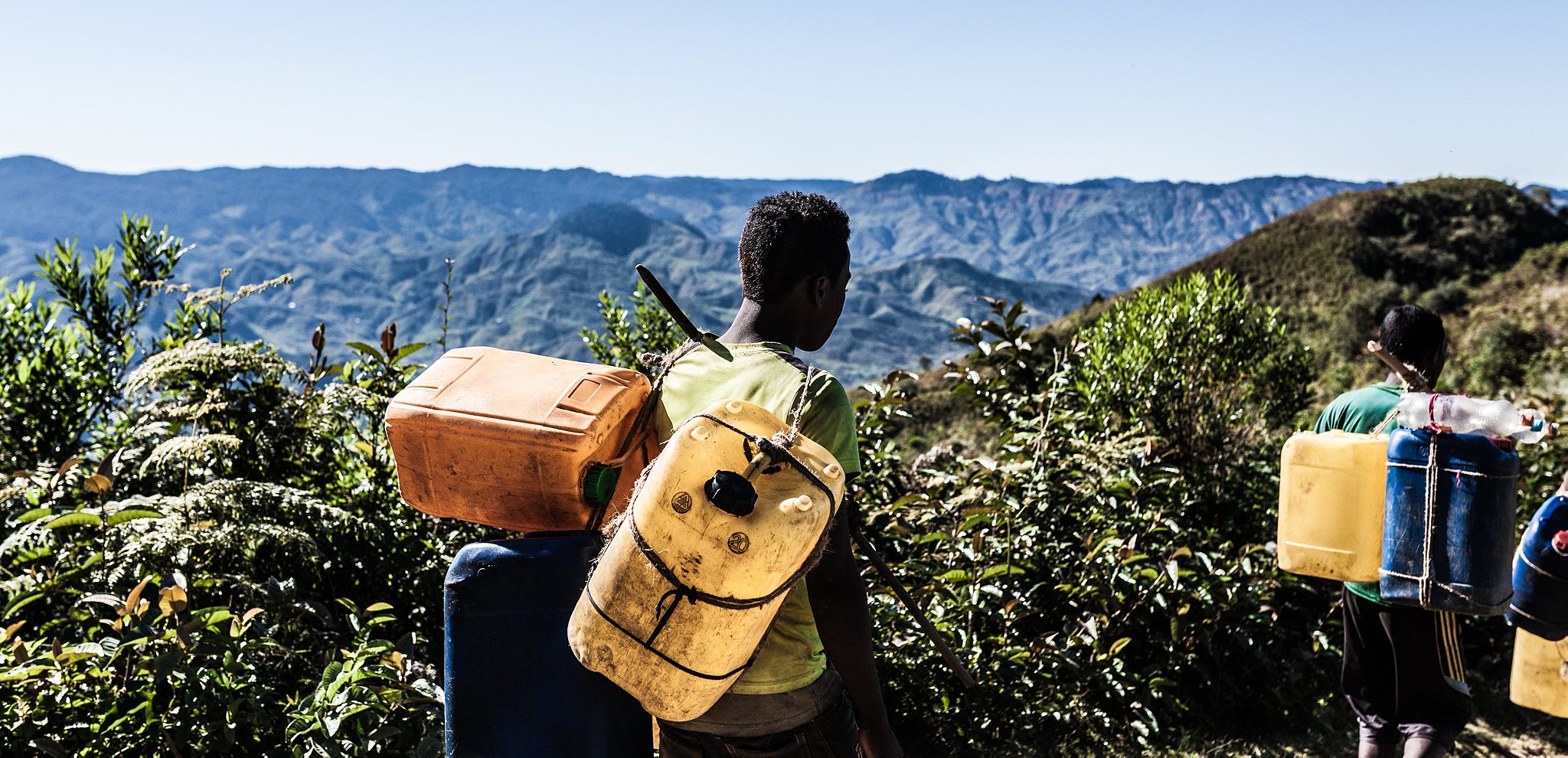
The finest toaka gasy of all originates in the isolated valleys at the eastern limit of the high plateau—the central band of the highlands that dominates inland Madagascar.
Here the lucrative combination of obscurity, climate, and proximity to Madagascar’s thirsty cities has driven up production to industrial levels and steeped the region’s culture and economy in the sale and consumption of toaka gasy.
All this had nothing to do with my visit. My immersion in moonshine, my present company and the drunken developments of the past week began with the innocent intention of attending a rodeo.
My friend and I were in the region to photograph the savika (Malagasy bull wrestling). It is a display of raw strength that pits teams of young men against zebu bulls—1,000-pound, foul-tempered bovines with horns and a hump. The event is held following celebrations in the thousands of tiny villages across the ancestral homelands of Madagascar’s Betsileo tribe. I had been confidently informed that Betsileo celebrations, and consequently savika, always take place on a Monday.
It was with a certain inevitability that arriving in the district capital on a quiet Sunday afternoon, we were unanimously informed that Betsileo celebrations, and consequently savika, in fact always take place on a Sunday morning, meaning that the region’s bulls had finished being wrestled for the week.
Hoping our original informant knew something those in the district capital did not, we turned off the main road onto the maze of dirt tracks that connect the countryside in search of fresh opinions on the matter.
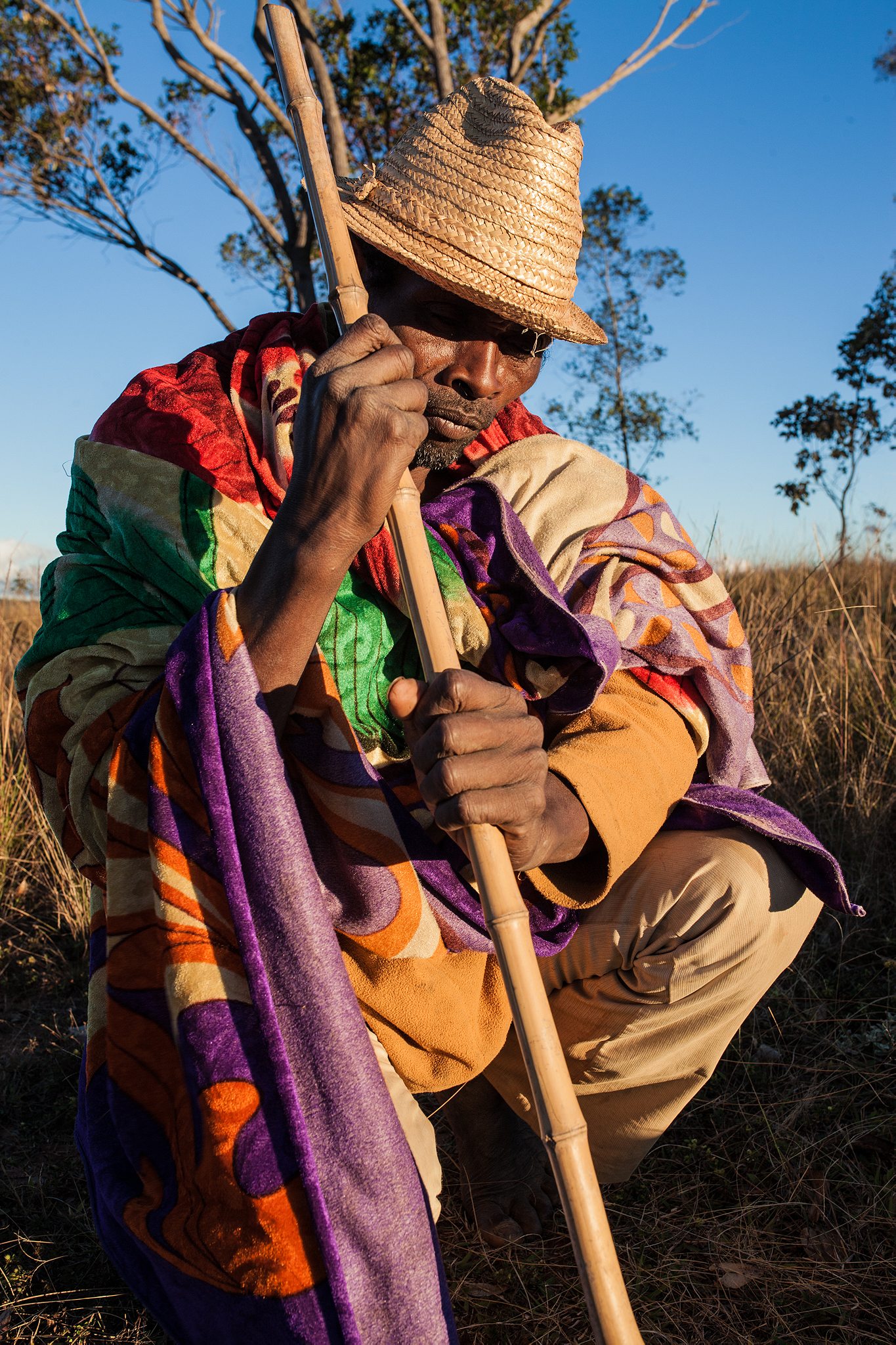
Unfortunately, the dirt tracks ahead of us were empty of either merchants or drivers so we pulled the Land Rover up at a cluster of houses built in the elegant, high-plateau style. Beneath, immaculately terraced rice paddies coiled along the lower slopes of the rolling hills–the signature landscape of the Betsileo. Everything was quiet and golden in the setting sun.
Through a crowd of children, an ancient figure approached, bent double over a cane. His head reached only a little higher than the children he passed, yet he arrived in front of me with a precision and speed that defied his form. Ignoring my greeting, he brought his lined face as close to mine as it could reach and squinted at me out of eyes lost behind milky cataracts. Then, without a word, he turned and disappeared into the nearest house.
Not sure what had just taken place, I glanced at my Malagasy friend for a clue. He gave me an unenlightening shrug and returned to leaning on his Land Rover. A few seconds later, the figure re-emerged bearing a tin cup, a plastic bottle, and the broadest, most infectious smile I have ever seen.
The old man poured a healthy measure of the bottle’s clear liquid into the tin cup and, screwing up his eyes, tipped the liquid down his throat. A healthy measure then followed for me and another for my friend, watched intently by the beaming old man and our audience of children.
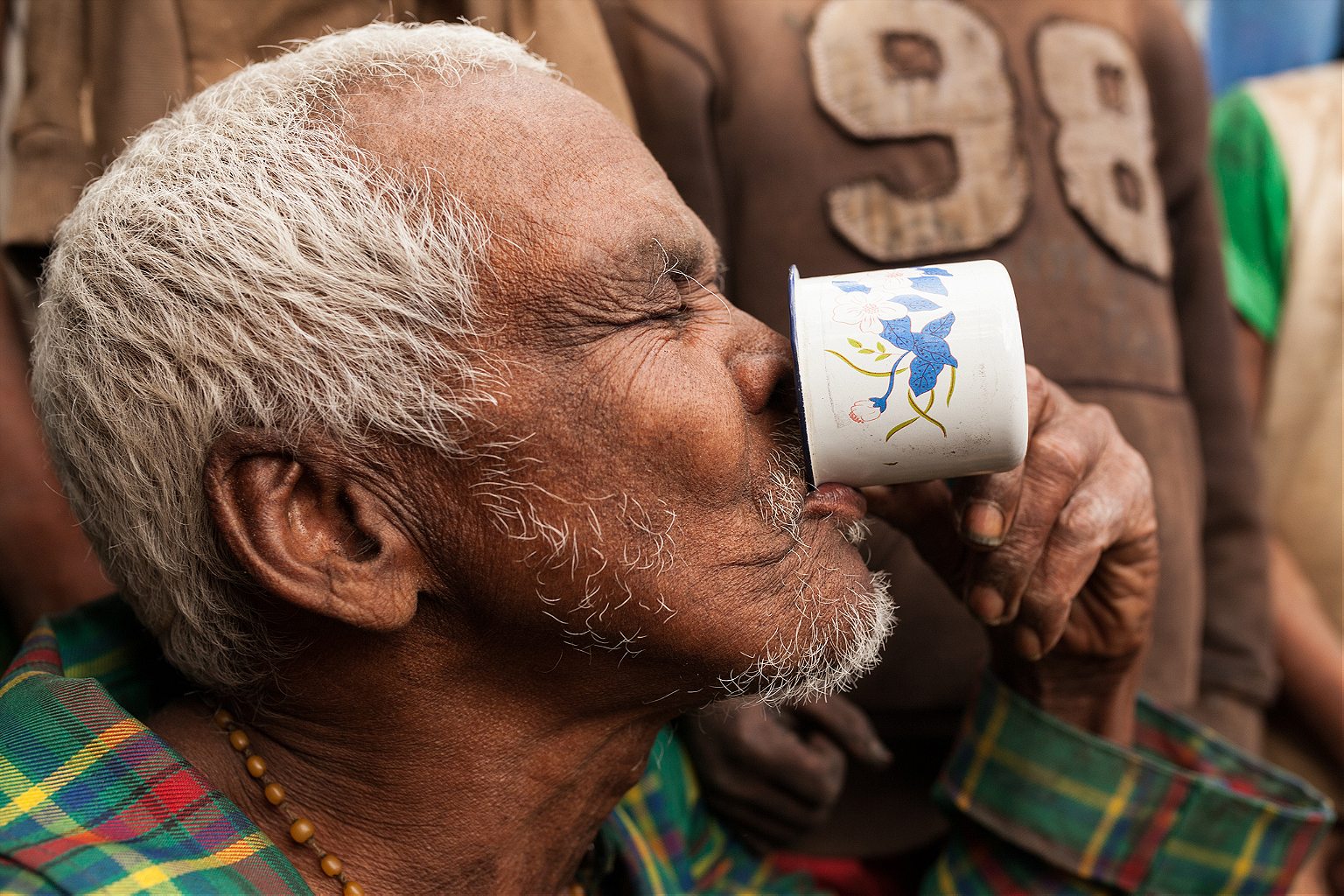
Only when my friend finished the mug of toaka did the old man break the silence: “tonga soa” (welcome). Throat still burning, I thanked him for his welcome and his hospitality then introduced my more linguistically capable friend who began to explain our purpose in the region.
The old man’s shaking head interrupted the explanation. “No. No savika on a Monday,” he said, “unless someone’s being circumcised, that is.” Then clarified with a chuckle, “but of course, no one is circumcised on a Monday so there will be no savika.” Maybe sensing my disappointment, the old man paused, then clapped his hands together and declared that he would send word to find out if any fools were circumcising their sons on a Monday. And that we could spend the night in his village while we waited for news. Smiling still, and shaking his head at the ridiculousness of a Monday circumcision, the old man began pouring out another round of drinks.
The next day’s inquisition in the surrounding villages followed a very similar pattern. Every individual we met would not divulge information until we had been formally welcomed with toaka gasy (‘toaka,’ as everyone referred to it). Each seemed to presume as well that this was my first ever taste of the regional speciality and so would pour me an extra-large glass. And I—aware that I was representing my nation’s reputation, keen to be polite, and secretly, increasingly fond of the liquid—would make sure I knocked these back with a smile.
By midday we were none the wiser about any forthcoming savika but sufficiently smashed to have forgotten about our hangovers. Realizing we were in need of a drink with an alcohol content below 50 percent ABV, but wary of getting off the booze too abruptly, we paused at a ramshackle bar to talk through strategy and drink beer.
The consensus from the morning’s encounters and the previous evening’s session, was that Sunday is indeed the day of circumcision, that we had arrived at the height of ‘circumcision season’ and that a savika is sometimes held to mark this glorious day in a young boy’s life. But as to where this may be happening we remained clueless and it occurred to me that going village to village, enquiring whether any young boys might be getting the snip, would appear peculiar.
Facing the prospect of returning empty-handed or alternatively, sitting on our hands for the next six days, a timely interjection changed the course of our quest. The two gentlemen on the next-door table, who had been discussing my presence since we arrived, finally bettered their inhibitions and called over to me. “Hey! Vazah!” (foreigner). “Try this.”
Raising a half bottle of what I confidently assumed to be toaka gasy, the men got to their feet and, ignoring our protestations, parked themselves at our table. Two more glasses arrived and were filled. Accepting that the day was lost, I turned the rum in the glass unenthusiastically, but just as I brought it to my mouth I caught a fragrance I had never before noticed in toaka gasy. The less inebriated of our two new friends read my expression and announced seriously, “Supatra. The best toaka in Madagascar.”
Leaning in, he explained that the fragrance comes from a leaf grown near the distilleries at the edge of the mountains. It sounded fanciful but, intrigued, I asked if he knew how to get there? “No,” he replied but assured me that he could introduce us to someone who did.
Speakeasies brought us to suppliers. Bootleggers led to black markets. Smugglers directed us over mountain tracks.
I now had a new goal. The next days passed in a swirl of toaka. Speakeasies brought us to suppliers. Bootleggers led to black markets. Smugglers directed us over mountain tracks. We stumbled east.
Each tough mile took us back decades to a place where the tracks narrowed and the valleys steepened and the Land Rover could proceed no further. Here the sparse villages had all but escaped the passing of time and the landscape held the weight of years unchanged.
We were invited to spend the night in the house of a smuggler. Before dawn of the next day, he said, we would begin the final leg of our journey on foot, accompanying his comrades from the other villages on the trail that linked the outside world to the source of the toaka.
And thus I find myself on this trail. It must be nearly 10 a.m. The forest has begun to steam in the climbing sun. And through gaps in the foliage, I glimpse narrow valleys below. We weave towards the mountain’s edge.
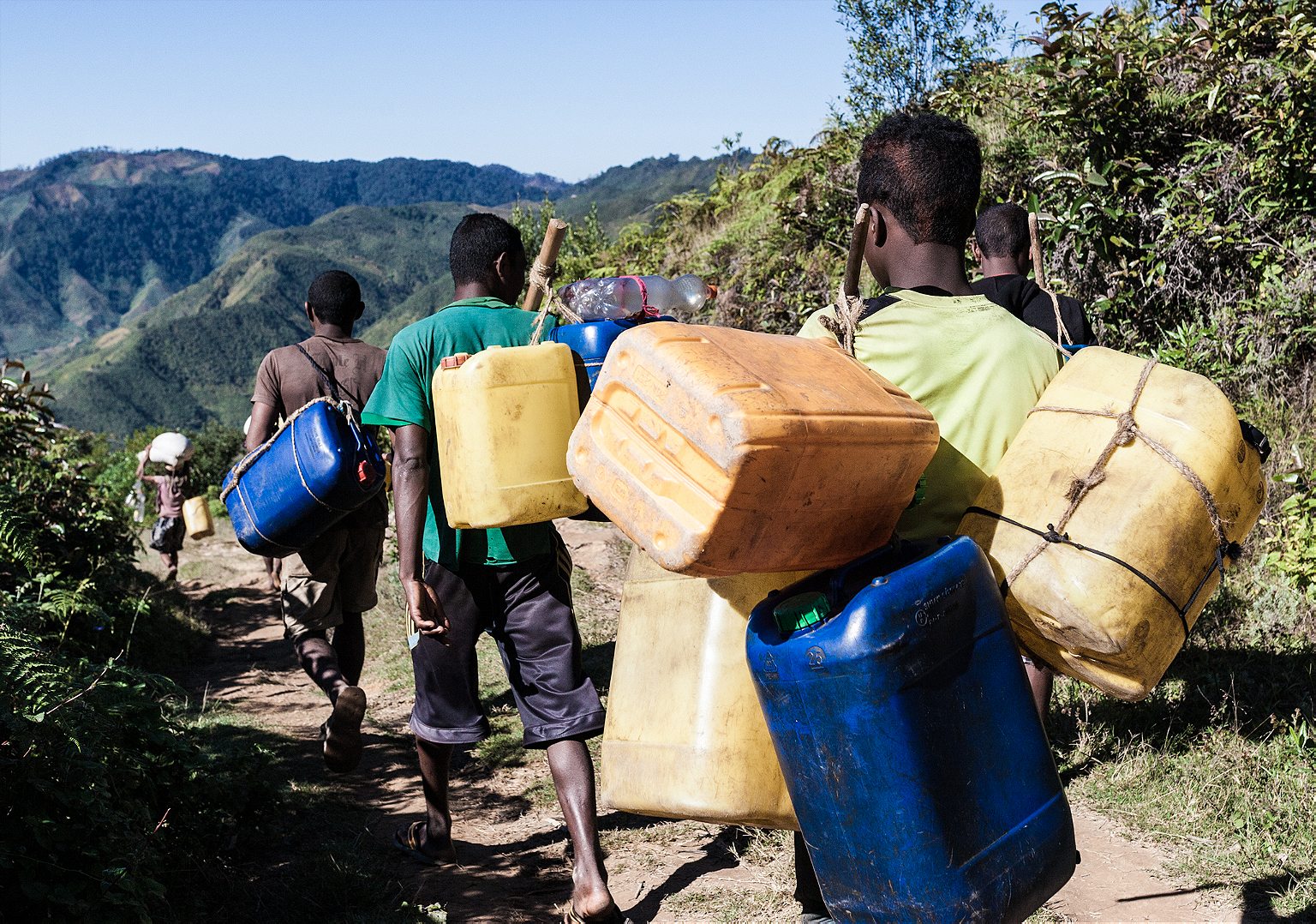
The prospect of a cumulative six-day hangover fills me with horror and I am pleased to notice that our pace has increased. There is some bustle ahead and behind as other smugglers dodge their way up the line. A seriousness has fallen over the light-hearted party that set out this morning and I sense we are nearing our destination, meaning the race to secure the best toaka has begun.
Blue-green sugarcane fields follow the folds of the mountain. Rice paddies spread across the valley floor. Tin dwellings, iridescent in the sunlight, hug the hillside. We have reached the Mecca of Madagascar’s moonshine.
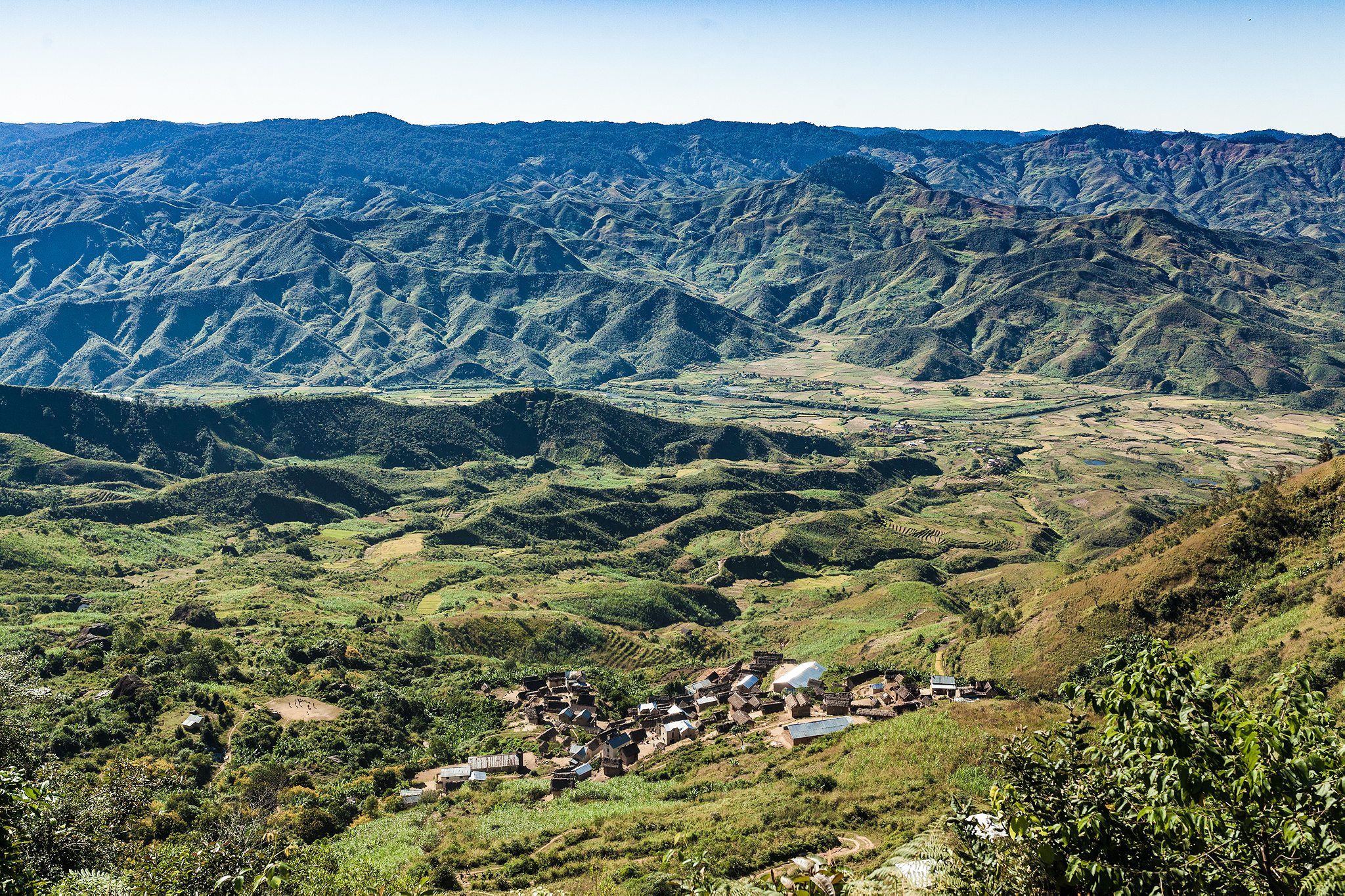
For 300 vertical yards we focus on picking our way down the series of hairpins cut into the valley’s edge. When the angle of the descent becomes less acute, I glance up from my feet to see we have arrived at a collection of buildings. Cliff walls tower behind me. Ahead, the mountain slopes into the valley floor.
Abruptly, we emerge into a clearing in the field. My eyes slowly adjust to the sun-drenched scene. The space is about 30 feet wide, walled by sugarcane with a large pit at the center. Three men, drenched in sweat and breathing heavily, stand at the edge of the pit. Each holds a tall wooden baton with both hands. As one, they raise the batons above their heads. Then with a grunt and a flex of sinewy muscle, they bring the batons down in an executioner’s stab, the tips crushing the contents of the pit. The men look up and meet my eyes but do not break the rhythm of their labor. I stand at the edge of the clearing and observe. Very slowly, it dawns on me that I have found the “factory.”
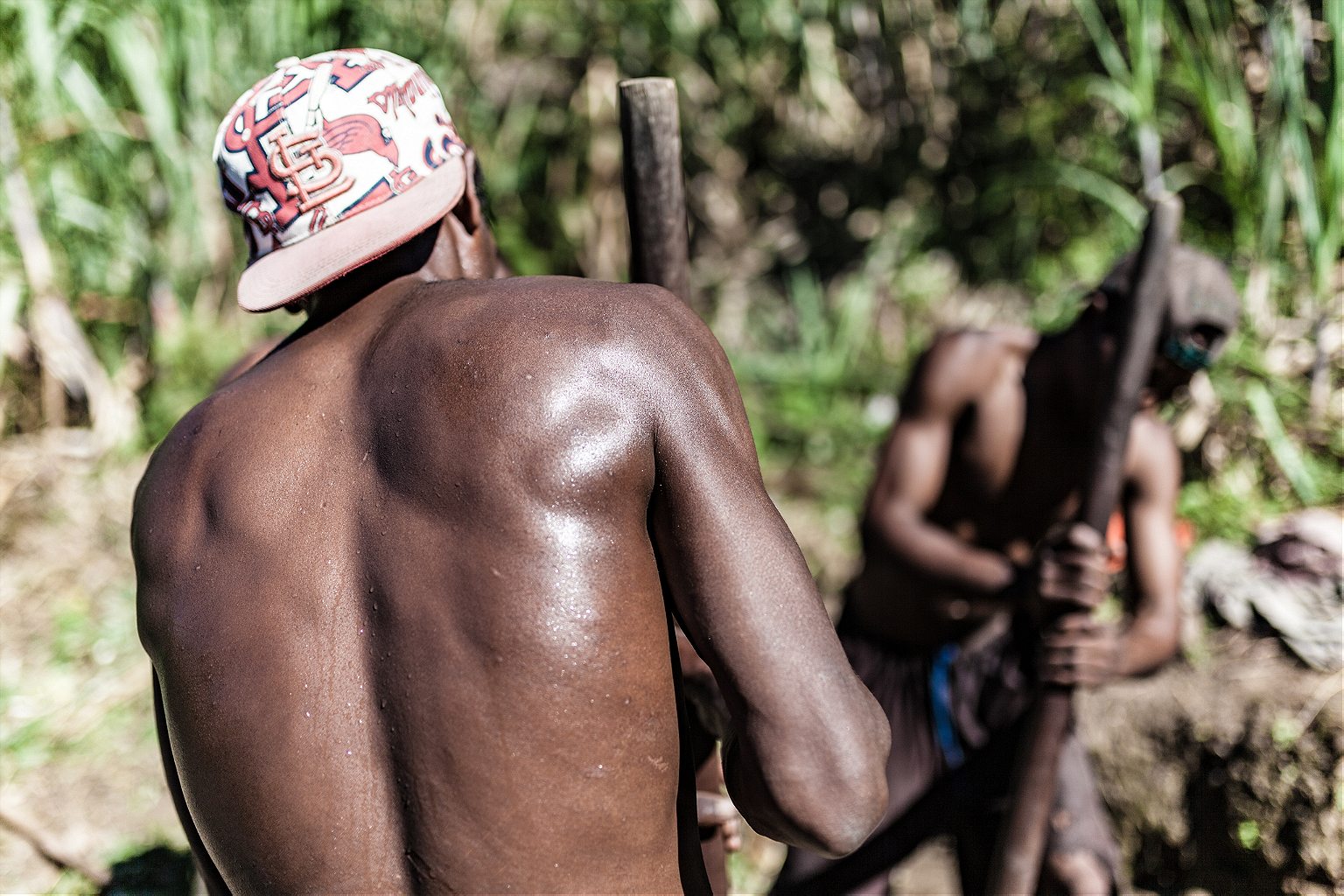

The men finish pulping the sugarcane in the pit and the tallest of the three approaches us. He introduces himself and his two friends and we take a seat in the shade. I explain my presence and ask about their endeavours. In response, he indicates the field around him. “My grandfather cleared the forest here to plant sugarcane. Then the land was my father’s. Now it is mine. I share the work here with my friends. Tomorrow and the next day we will be working their fields.” He points towards three anvil-shaped rocks next to a stack of sugarcane. “We crush the cane here and mix it over there.” He nods towards a pile of vegetable matter where pale sugarcane splinters sit amongst vivid green leaves.
“Supatra,” I offer.
He nods again. “The holes are dug and we build a fire inside that hardens the earth.” Looking at clay soil below my feet, the ingeniousness of it strikes me—with spades and embers they have fired a giant clay container. “Then we juice it, cover it with bamboo leaves and let it ferment for a week.”
It’s a succinct explanation but lacks the passion that I am hoping to capture. Keen to uncover professional pride, I attempt some flattery, asking what makes his rum better than the other distillers. He answers diplomatically that all the toaka in the valley is much the same, just some dilute the rum more than others. “Is the recipe a secret?” I enquire. An exchange follows between my friend and the moonshiner that reveals some confusion with my question or its translation. Trying another angle, I ask how he came to learn the process. He indicates his children who stand at the edge of the clearing, chewing on sugarcane and spitting out the dry fibers; watching. “So, the recipe has always been the same?”
Here in the valley there is only this. What else can I hope for?
“Yes.” Did he have any ideas to improve on the recipe? Again, the question falls flat. I enquire whether he hopes for the same life for his children? He considers this one, musing that he has family in the regional capital but no means to visit them and less reason to think they could support his children out there. Then shakes his head, saying, “Here in the valley there is only this. What else can I hope for?” I can see his friends are eager to return to the task in hand so we thank them for their time and promise to pass by their house before we leave to sample their toaka gasy.
Back on the trail, the direction of flow has changed. Rather than the endless downhill stream of smugglers, individual groups make their way back up the slope. The bouncing jerry cans now bulge with toaka and sit heavily on their owner’s shoulders. The smugglers move with grace. The sweat on their brows and the determination in their eyes is the only evidence of the strain of carrying 40 liters of liquid in uncomfortable containers up a half-mile of cliff. And I am struck by the sadistic decision to locate the toaka market the maximum vertical distance from those whose job it is to transport it.
Our host explains these first groups will have secured the best toaka on offer today. I ask how they are able to assess so much choice so quickly. He mimics my earlier gesture of downing a glass of toaka, “but mostly you get to know the vendors.”
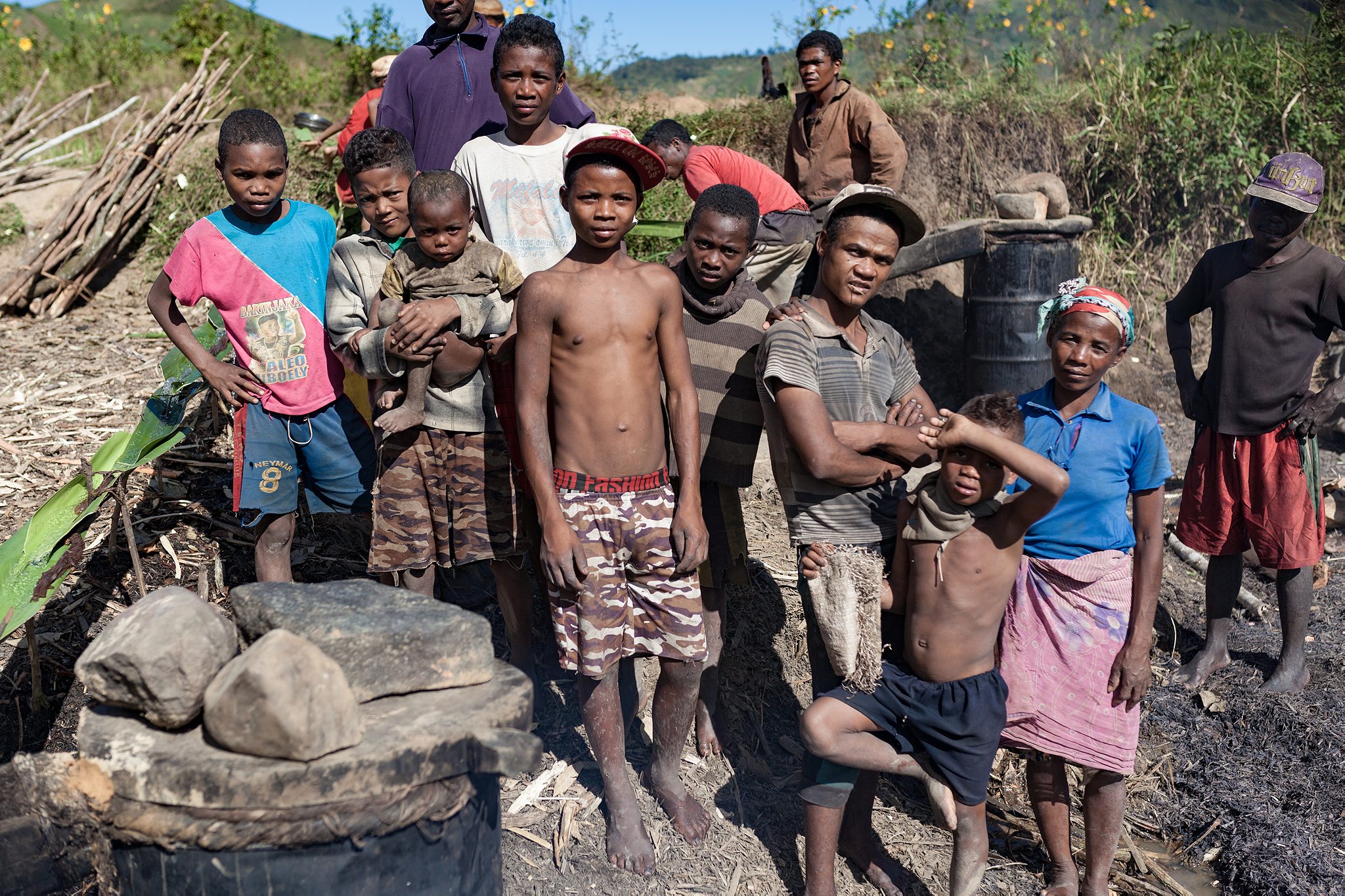
At the heart of the valley lies the market. As with most of the black markets we had passed through, it is little more than a patch of well-trodden ground that someone at one stage designated as an acceptable spot for illicit activity. Business seems to be winding down for the day. Only 50 or so of the hundreds of smugglers I had seen on the trail were present. Of these, most had finished negotiations and are enjoying a moment of rest before facing their return journey. Two men in military uniforms overlook the proceedings. They pretend not to notice me as we enter the market. I oblige their collusion in the illegal activities below by not pointing my lens in their direction.
Our host approaches one of the vendors, a man sitting on a yellow jerry can with the serenity of a monk in meditation. He’s in his 50s, his brow bears the deep lines of a man who has spent years squinting against the sun, and his shoulders show the deformation I have begun to notice in the smugglers. My friend and I kneel while our host explains our quest to this valley. Inscrutable, the vendor removes the cap of one of the jerry cans, fills it, drinks.
Its sweet floral odor hangs in the air. A sinister hangover has been developing for the last hour. I am beginning to think that leaving the valley on my own two legs will be out of the question, and have been toying with images of my suffering body being stretchered out by kindly smugglers. But self-respect kicks in. I need to postpone my suffering till I have access to Ibuprofen and air-conditioning. This game plan in mind, I snatch slightly at the drink offered to me by the vendor. It does not go unnoticed and the hint of a knowing smile breaks on the cheeks of his lined face. He refills the cap and passes it back to me. I don’t protest.
The vendor explained that he had worked as a smuggler and distiller as well as a vendor. And he tells the valley’s story as that of a recipe that was born “before the memories of generations” and a process that has remained unchanged in at least the vendor’s own lifetime. He describes the journey of toaka from the valleys to the cities. In doing so, he traces our quest in reverse, right back to the black markets near the district capital where we first picked up the bootlegger’s trail; and beyond, to the trucks, busses and taxis that smuggle the product of these valleys to Madagascar’s urban centers.
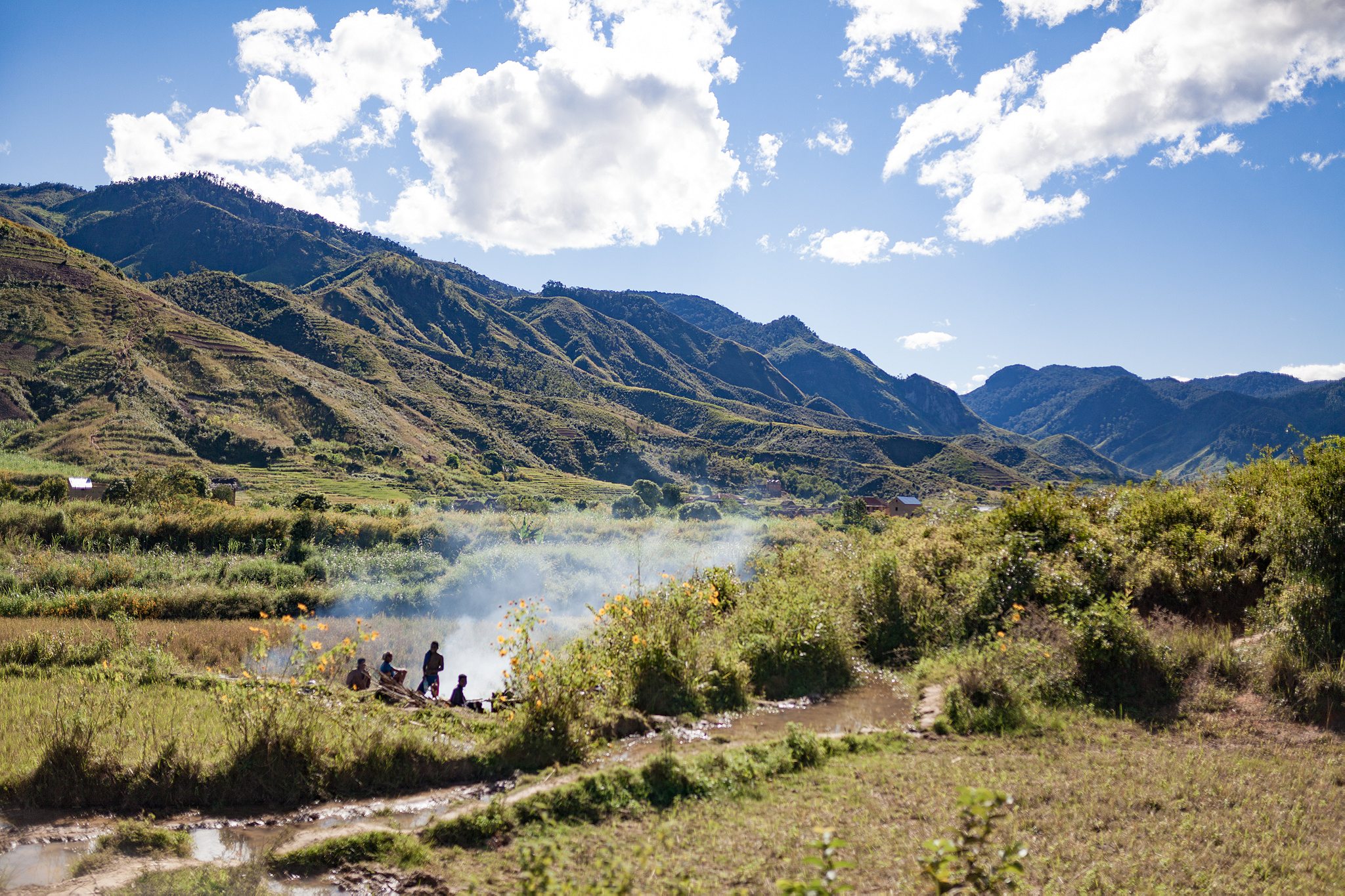
There is pride in the way he describes his wealthy countrymen in their big cities enjoying the toaka of this valley. When I ask him to elaborate on how he perceives his role in this tradition he simply replies that “there is nothing in Madagascar without toaka gasy.” Indicating the uniformed men, he goes on, “even the officials know this. They can’t stop the toaka. The bribes we pay are little more than a tax.”
I ask him whether he has considered innovations that might give him a competitive edge in this market: whether the process could be made more efficient, whether his toaka gasy could be infused or aged after distillation like whiskey. He replies that he had considered it but asks me where I thought he would get the money to buy machinery or where he could find a safe place to keep his toaka while it aged?
At a bend of the river, on a pile of blackened husks, a dozen children dash between an array of metal, foliage, and wood. With deft actions, they respond to the commands of a teenager in a flat cap, whose jaw remains clenched around a toothpick. There is a harshness about the teenager’s demeanour and he makes a point of refusing to acknowledge our presence. Conscious that we are guests in his domain, we wait at the fringes of the rice paddies, giving us a chance to take in the operation before us.
Near my feet, an irrigation channel had been diverted, directing the water into a guttering system constructed out of bamboo leaves. The diverted water flows along these leaves and into a hewn wooden trough which encloses a metal pipe. The higher end of the metal pipe is attached to a blackened oil drum that sits on top of a wood fire. At the lower end of the pipe—once it had passed through the trough of cool running water—is a wooden peg from which a dribble of liquid is collected in empty Coke bottles before being decanted into waiting jerry cans.

It takes some time to decipher the process as the scene is in a constant state of apparent chaos. The bamboo guttering is supported by a precarious series of forked twig pylons that are constantly collapsing, cutting off the water supply to the condenser. The fire beneath the oil drum needs permanent attention to regulate the temperature. The bottles at the end of the pipe are in perpetual danger of overflowing. And a flock of chickens that seem intent on foraging around the distillery threaten every element of the operation and require vigilant and continuous policing.
Eventually the teenager in charge approaches our host, shakes hands and nods at my friend and me. His crew of distillers are his brothers, sisters, and cousins and are aged between 10 and 17. On distilling days, this crew digs the fermented sugarcane pulp from its earthenware holes, bags it, and boils off the alcohol. It is possible to achieve a second and even a third distillation by adding water to the fermented mash once the first distillation had slowed.
He is not especially talkative, but enjoys having his photograph taken and seems to appreciate the attention we give him as he goes through the stages of the process.
A tasting session follows their final distillation of the day and I attempt a connoisseur’s appraisal. In my notes this reads, “nose is powerful with [hints of] floral and black pepper. On the tongue [,] the heavy taste of wet wood but a light fruity body. Leaves something vegetal, reeds [or] straw.” Evidence that I make a pretentious drunk.
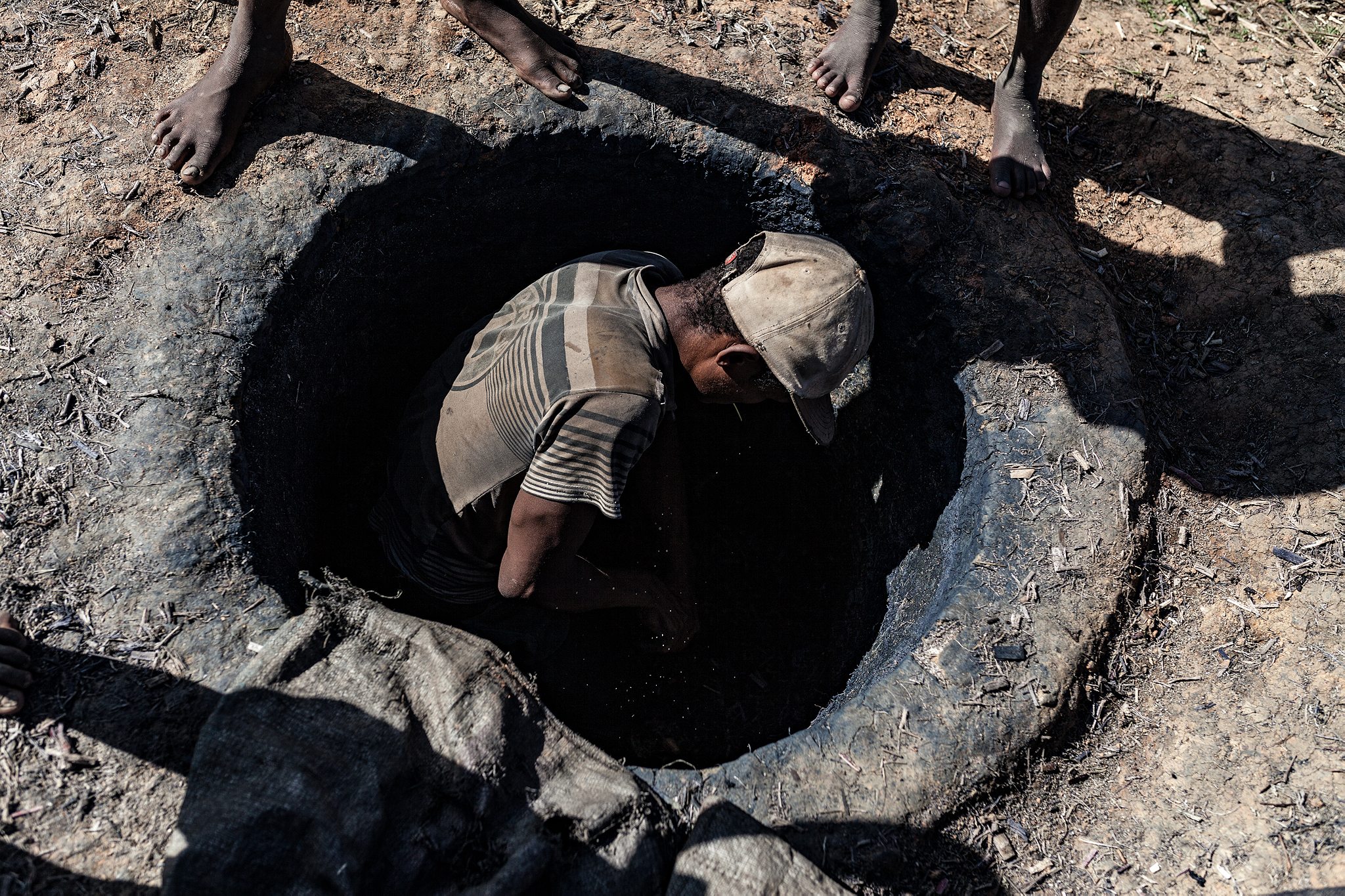
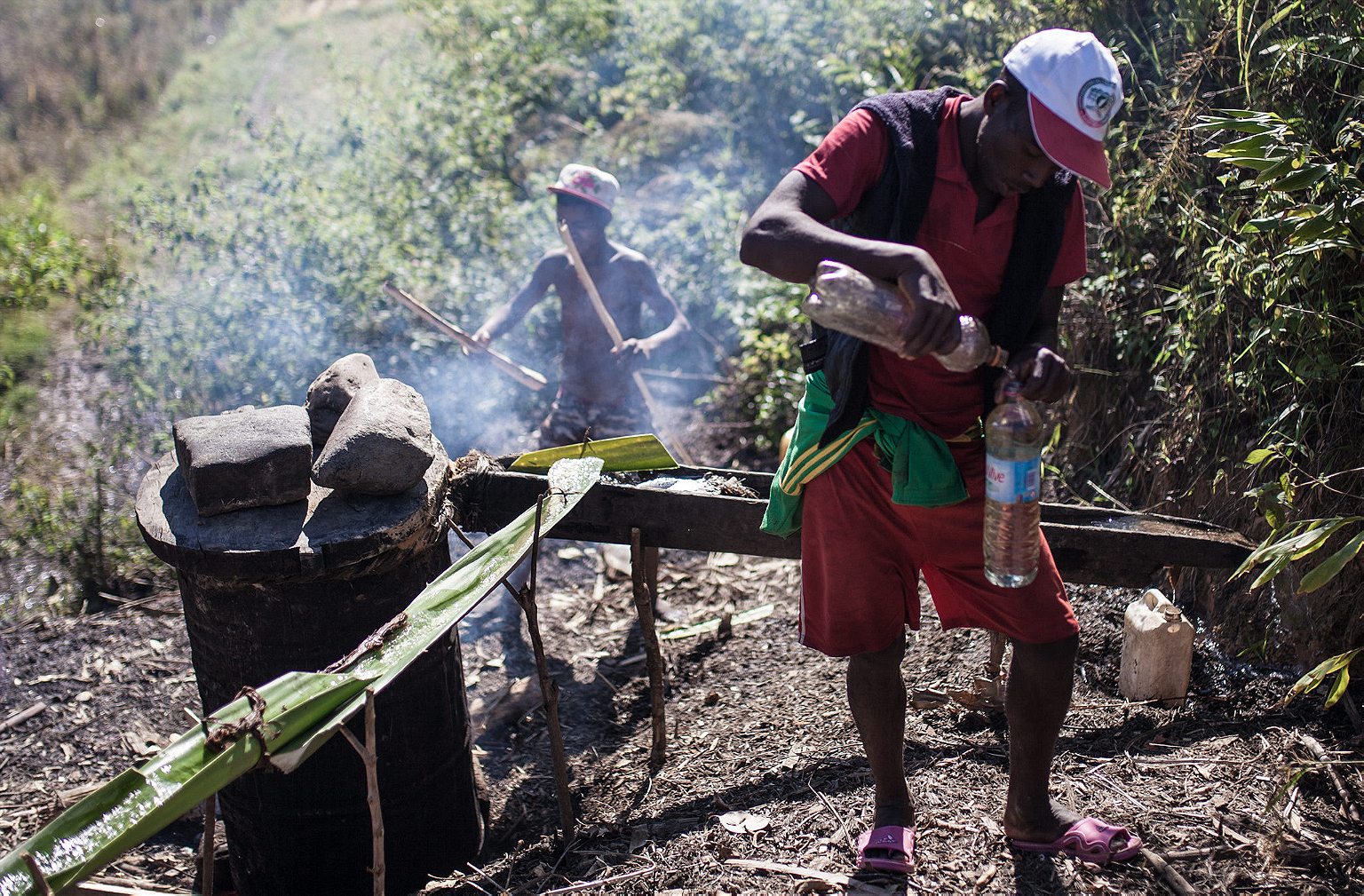

The darkening trail is empty as we make our way out of the valley. The other smugglers will be back at their villages, snatching some brief sleep before they embark on the second stage of their journey—to the black markets and back. I imagine myself walking this trail every two days, earning 15,000 Malagasy ariary (about US$5) per roundtrip.
Then another thought, more disturbing, crosses my mind. Something one of the kids at the distillery said. “Why is it vazahs” (foreigners) “are so interested in poverty?” He had said it in French and it had caught me off guard. I remember answering with something inane about differences between cultures, to which the boy did not respond. I wondered at the time whether I had misheard or he had not fully understood what he was saying. And in the busyness of the moment I hadn’t fully considered the question or thought to enquire further of its owner. But now, with my head clearing once more, this uncomfortable question came back to me.
I had arrived at the valley half expecting quaint micro-distilleries; maybe a guild hall where the lineages of master tasters are traced back through the ages; or a council of elders, elected to oversee that traditional practices are rigorously adhered to. I had expected to see a pride in this ancient moonshining craft. Instead I witnessed a labor of sweat born of necessity, practiced for lack of any alternative.
As shame settles on me I contemplate the extraordinary strength and marvellous ingenuity displayed by the many bootleggers I had met over the last six days. The endurance of the smugglers, expertise of the vendors, and honed technique of the distillers are all worthy of acclaim. That they have little time for self-congratulation does not mean others should not respect and appreciate their work.
Conversation interrupts my thoughts. My friend is asking whether I want to accompany the smugglers on their next leg to the black market; they will be leaving just after 1 a.m. My legs are shot and my body is suffering, and my friend looks in similar shape. I decline the offer.
In any event, tomorrow is Sunday, and we have confirmation of a savika taking place in a village just three miles away. My thoughts turn to how I will fare in the ring with a bull. I should probably keep drinking.
